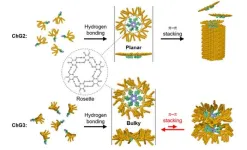(Press-News.org) A new comprehensive survey has highlighted an urgent need to enable more farmers and contractors to revive England’s hedgerows to meet national restoration targets. While agri-environment schemes (AES) have improved the condition of these iconic landscape features, the overall length of hedgerows remains unchanged.
Hedgerows act as field boundaries, protect livestock, support biodiversity and help mitigate climate change. However, around half of these important habitats were lost in the post-war years due to agricultural intensification. In the 2007 Countryside Survey, fewer than 50% of remaining hedgerows were judged to be in good structural condition.
The UK Centre for Ecology & Hydrology repeated the hedgerow survey across England in a new project for Natural England. Defra has set a target to create or restore 45,000 miles of hedgerow by 2050.
UKCEH used the data to review the effectiveness of the agri-environment schemes (AES) for hedgerows and carried out a questionnaire of around 400 farmers and contractors to gain a better understanding about their hedge management practices.
Key findings
The England hedgerow survey shows that, overall, agri-environment schemes have had a positive impact on hedge condition, and that more recent schemes are supporting more restoration and planting of new hedges.
Findings of the UKCEH report, An evaluation of Agri-Environment Scheme impact on hedgerows in England, include:
There was no statistically significant change in the overall length of managed hedgerows in England between 2007 and 2023, which is estimated to have remained at around 400,000km.
The proportion of hedgerows in good structural condition increased from 43% to 55% between 2007 and 2023. For hedgerows under AES the figure rose to 63.5%, compared to 46.8% for those outside such schemes.
Hedgerow height generally increased between 2007 and 2023 with the majority of hedges now taller than two metres, rather than in the one to two metre category. Hedges under AES were slightly taller than those outside schemes.
Many hedges have deteriorated in recent years due a lack of ongoing maintenance, resulting in gappy hedges or lines of trees.
The diversity of plant species at the base of hedgerows has not improved.
Biodiversity and climate benefits
Defra aims to create or restore 30,000 miles of hedgerow by 2037 and 45,000 miles by 2050. However, the Climate Change Committee recommends that the national hedgerow network should be increased by 40% by 2050, while Natural England’s long-term aspiration is a 60% increase in hedgerow extent to support thriving plants and wildlife.
Dr Lisa Norton, the UKCEH agro-ecologist who led the hedgerows study, says: “There are signs that agri-environment schemes are having a positive effect on the condition of England’s hedgerows. However, efforts to meet national targets for lengths of managed hedges are falling short.
“To meet national targets, we urgently need to increase participation in these schemes among farmers and landowners through better incentives and advice so they can rejuvenate our network of hedgerows.”
Dr Norton emphasises that increased planting and better management, including laying and coppicing, would maximise hedges’ ability to capture and store carbon, helping us reach net zero. It would also provide more habitat for insects, nesting birds and small mammals, supporting ecosystem services such as pollination and natural pest control, as well as enhance our landscapes.
In addition to AES funding, many non-governmental organisations such as the Woodland Trust provide funding and support for hedgerow and tree planting.
Farmers’ feedback
UKCEH’s survey revealed that farmers are keen to maintain their hedges both to protect livestock and improve local wildlife. However, they highlighted the need for adequate funds for planting, establishment, and ongoing management of hedges.
Agricultural contractors reported that agri-environment schemes had been designed without their input and said there had been numerous issues with managing hedgerows in line with the schemes’ regulations, affecting their businesses. They also highlighted the potential advantages of investing in farmer and contractor training in hedgerow management.
The results of UKCEH’s survey and study will be used to shape future policies and strategies aimed at increasing the quantity and quality of hedges across England. The report and a summary are available on the Defra website.
- Ends -
Media enquiries
For interviews and further information, please contact Simon Williams, Media Relations Officer at UKCEH, via simwil@ceh.ac.uk or +44 (0)7920 295384.
Notes to Editors
Surveyors recorded the lengths, locations and attribute, such as height, width and management, of all hedgerows in the English Countryside Survey squares. Plots sampling species and additional hedgerow attributes in both the woody component and the area below and adjacent to hedgerows were recorded for both randomly sampled hedgerows and for hedgerows under agri-environment scheme options in squares.
UKCEH’s questionnaire complemented a separate survey of farmers, commissioned by CPRE, which showed strong support for government plans to increase our hedgerow networks but highlighted a lack of funding is by far the biggest obstacle to planting and maintaining hedgerows.
About the UK Centre for Ecology & Hydrology (UKCEH)
The UK Centre for Ecology & Hydrology (UKCEH) is a leading independent research institute dedicated to understanding and transforming how we interact with the natural world.
With over 600 researchers, we tackle the urgent environmental challenges of our time, such as climate change and biodiversity loss.
Our evidence-based insights empower governments, businesses, and communities to make informed decisions, shaping a future where both nature and people thrive.
www.ceh.ac.uk / @UK_CEH / LinkedIn: UK Centre for Ecology & Hydrology
END
Urgent need to enable more farmers and contractors to revive England’s network of hedgerows
Agri--environment schemes have improved the hedges' structural condition but not overall length
2024-11-21
ELSE PRESS RELEASES FROM THIS DATE:
ASH inclusion program retained and engaged hematologists underrepresented in field, 20-year analysis shows
2024-11-21
(WASHINGTON, Nov. 21, 2024) — Participants of the American Society of Hematology (ASH) Minority Recruitment Initiative had lower attrition rates in graduate and medical programs, were more likely to pursue a career in hematology, and had high levels of engagement at ASH beyond their participation in the program, according to a study published today in Blood Advances.
The ASH Minority Recruitment Initiative was established in 2003 following a report from the Institute of Medicine that called for greater workforce diversity. The program aimed to recruit physicians and physician/scientists from communities ...
How anti-obesity drugs are linked to food waste
2024-11-21
COLUMBUS, Ohio – Taking anti-obesity drugs has led some U.S. adults to throw away more food than they tossed before starting the medications, a new study has found.
In a survey of people currently on GLP-1 medications such as Ozempic, 25% of respondents agreed they had wasted more food since taking the drugs, compared to 61% who disagreed. People who were nauseated by the drugs were more likely to report increased food waste. Being on the medications for a longer period of time and eating more vegetables were associated with less food waste.
Scientists at The Ohio State University see this study of consumer behavior as an initial effort to consider the effects ...
Discovery explains kidney damage caused by blood pressure drugs
2024-11-21
University of Virginia School of Medicine researchers have discovered how long-term treatment of high blood pressure with commonly prescribed drugs can destroy the kidney’s ability to filter and purify blood. The finding could open the door to better ways to manage high blood pressure and other vascular diseases.
The class of drugs, known as renin–angiotensin system (RAS) inhibitors, block the effects of the renin enzyme, relaxing blood vessels and allowing blood to flow more easily. They are widely used as first-line medications for hypertension (high blood pressure). But long-term use can take a terrible toll on the ...
NYU Langone performs world’s first fully robotic double lung transplant
2024-11-21
NEW YORK, NY, NOV. 21, 2024—A surgical team at NYU Langone Health has performed the first fully robotic double lung transplant in the world. The procedure marks a breakthrough in the potential of robotic surgery and minimally invasive patient care, making NYU Langone the new leader in robotic transplant surgery around the globe.
Stephanie H. Chang, MD, associate professor in the Department of Cardiothoracic Surgery at NYU Grossman School of Medicine and surgical director of the Lung Transplant Program ...
APSS accepting sleep and circadian research abstracts and session proposals for SLEEP 2025 in Seattle
2024-11-21
DARIEN, IL – The Associated Professional Sleep Societies is accepting research abstracts and session proposal submissions for SLEEP 2025, the 39th annual meeting of the APSS, which will be held June 8 to 11 at the Seattle Convention Center.
Research abstracts will be accepted for oral and poster presentations. Hot topics for 2025 include machine learning and artificial intelligence, metabolomics and genomics, sleep and the glymphatic system, orexin pharmacology, and obesity management. Accepted abstracts ...
DNA repair: A look inside the cell’s ‘repair café’
2024-11-21
New research from the Kind Group at the Hubrecht Institute sheds light on how cells repair damaged DNA. For the first time, the team has mapped the activity of repair proteins in individual human cells. The study demonstrates how these proteins collaborate in so-called "hubs" to repair DNA damage. This knowledge offers opportunities to improve cancer therapies and other treatments where DNA repair is essential. The researchers published their findings in Nature Communications on November 21.
DNA is the molecule that carries our genetic information. It can be damaged by normal cellular processes as well as external factors such as UV radiation ...
Astronomers take the first close-up picture of a star outside our galaxy
2024-11-21
“For the first time, we have succeeded in taking a zoomed-in image of a dying star in a galaxy outside our own Milky Way,” says Keiichi Ohnaka, an astrophysicist from Universidad Andrés Bello in Chile. Located a staggering 160 000 light-years from us, the star WOH G64 was imaged thanks to the impressive sharpness offered by the European Southern Observatory’s Very Large Telescope Interferometer (ESO’s VLTI). The new observations reveal a star puffing out gas and dust, in the last stages before it becomes a supernova.
“We discovered an ...
Here’s something Americans agree on: Sports build character
2024-11-21
COLUMBUS, Ohio – In a polarized nation, there is one thing that nearly all Americans agree on, according to a recent study: Sports are good for us.
Researchers from The Ohio State University and Ithaca College found that more than 9 out of 10 Americans agreed that sports build character and improved one’s health, while 84% agreed playing sports makes one popular in school and 85% said it makes one more well-known in the community.
According to 67% of those surveyed, playing sports even leads to better grades in school.
While these beliefs may seem harmless, ...
Engineering nature’s blueprint: Dendron-based assemblies for chlorophyll’s materials
2024-11-21
Researchers often look to photosynthesis—a process that turns sunlight into chemical energy in plants and bacteria—as a model for innovation. Photosynthesis is in turn linked to chlorophyll pigments, tiny green molecules that play a key role in harvesting light. Naturally, these chlorophyll molecules are organized into precise structures to optimize light absorption in plants and bacteria, and efficiently capture sunlight for energy. Inspired by this natural structure, scientists have explored ways to synthetically assemble chlorophyll-based ...
Study reveals how cell types shape human brain networks
2024-11-21
Rutgers researchers at the Brain Health Institute (BHI) and Center for Advanced Human Brain Imaging Research (CAHBIR) have uncovered how different types of brain cells work together to form large-scale functional networks in the human brain – interconnected systems that support everything from sensory processing to complex decision-making – paving the way for new insights into brain health and disease.
By pinpointing these cellular foundations, the study, published in Nature Neuroscience, offers a deeper understanding of the cellular foundations of cognition and mental health.
The brain’s functional properties arise from the varied ...
LAST 30 PRESS RELEASES:
Sleeping in on weekends may help boost teens’ mental health
Study: Teens use cellphones for an hour a day at school
After more than two years of war, Palestinian children are hungry, denied education and “like the living dead”
The untold story of life with Prader-Willi syndrome - according to the siblings who live it
How the parasite that ‘gave up sex’ found more hosts – and why its victory won’t last
When is it time to jump? The boiling frog problem of AI use in physics education
Twitter data reveals partisan divide in understanding why pollen season's getting worse
AI is quick but risky for updating old software
Revolutionizing biosecurity: new multi-omics framework to transform invasive species management
From ancient herb to modern medicine: new review unveils the multi-targeted healing potential of Borago officinalis
Building a global scientific community: Biological Diversity Journal announces dual recruitment of Editorial Board and Youth Editorial Board members
Microbes that break down antibiotics help protect ecosystems under drug pollution
Smart biochar that remembers pollutants offers a new way to clean water and recycle biomass
Rice genes matter more than domestication in shaping plant microbiomes
Ticking time bomb: Some farmers report as many as 70 tick encounters over a 6-month period
Turning garden and crop waste into plastics
Scientists discover ‘platypus galaxies’ in the early universe
Seeing thyroid cancer in a new light: when AI meets label-free imaging in the operating room
Neutrophil-to-lymphocyte ratio may aid risk stratification in depressive disorder
2026 Seismological Society of America Annual Meeting
AI-powered ECG analysis offers promising path for early detection of chronic obstructive pulmonary disease, says Mount Sinai researchers
GIMM uncovers flaws in lab-grown heart cells and paves the way for improved treatments
Cracking the evolutionary code of sleep
Medications could help the aging brain cope with surgery, memory impairment
Back pain linked to worse sleep years later in men over 65, according to study
CDC urges ‘shared decision-making’ on some childhood vaccines; many unclear about what that means
New research finds that an ‘equal treatment’ approach to economic opportunity advertising can backfire
Researchers create shape-shifting, self-navigating microparticles
Science army mobilizes to map US soil microbiome
Researchers develop new tools to turn grain crops into biosensors
[Press-News.org] Urgent need to enable more farmers and contractors to revive England’s network of hedgerowsAgri--environment schemes have improved the hedges' structural condition but not overall length




